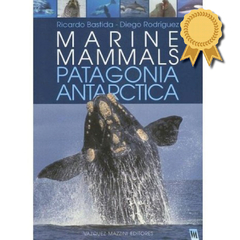Marine Mammals - Patagonia & Antarctica
MARINE MAMMALS - PATAGONIA & ANTARCTICA
Ricardo Bastida - Diego Rodríguez / Vazquez Mazzini Editores
¡LIBRO PREMIADO! - Ganador del Primer Premio al Mejor Libro Editado en la Argentina, Categoría Libros de Estudio y Consulta, otorgado por la Cámara Argentina de Publicaciones.
The historically renowned Argentine coast south of the Río Negro is also world famous for the annual spring residency of the Southern Right Whales, and the occurrence of Orca, the killer whale. The right whales congregate around Península Valdés during winter and spring, and provide the Province of Chubut with one of its major tourist attractions. The Orca´s habit of beaching themselves to catch sea lions has been well publicized and has fascinated TV watchers world-wide. But right whales and the predatory orcas are not the only species of marine mammals found on the Patagonian coast. Washed by the north-flowing cold currents, which emanate from Antarctic waters, the coast is host to a variety of large whales which pass though en route from the deep south to spend the winter in the tropics. There are also a number of smaller species of beaked whales, dolphins and seals in those coastal waters, some of which are permanent residents in Patagonian waters.
Field guides to marine mammals have a basic purpose: to provide information on the lives and identities of species, so that those who are interested in life in the sea can understand what they are looking at, why the particular species are where they are, and what they are doing there. An appreciation of these aspects of cetacean life is fundamental to understanding how humans should interact with these animals, and how their environment should be carefully managed.
The world-wide development of whale and dolphin watching as a tourist activity has already reached the largely pristine coastal waters of southern South America, and the publication of this guide book is, therefore, extremely timely. Research workers and lay persons alike will derive much from this new edition with updated and improved information, and if as a result, there is a growing public awareness of the nature of the cetacean fauna of Patagonia and the threats to it, which lead to enhanced conservation of the species, the guide book will have been a success. I have no doubt that will be the case.
Essential for identifying marine mammals of Southern South America and Antarctica 50 species - 205 color photographs - 90 illustrations - 54 maps
It describes in everyday language, but with scientific rigor, the characteristics of each species: common and scientific names, weight, size, geographic distribution and behavior, and offers a key to identification for sightings and strandings, conservation and much more.
Idioma inglés - 24 x 17 cm - 208 páginas a todo color en papel ilustración.






























































